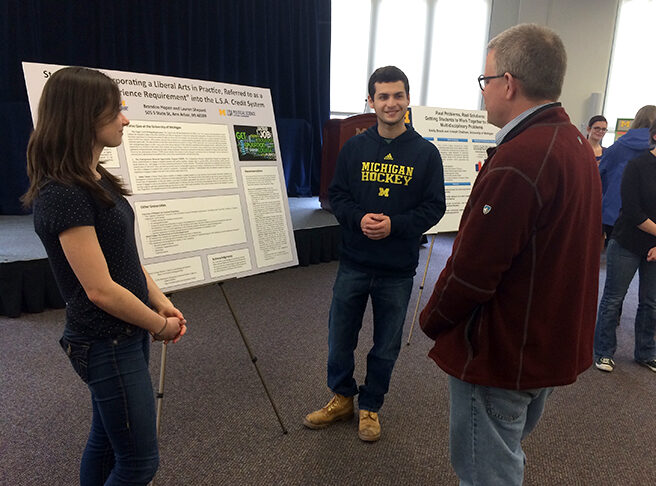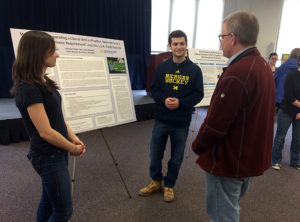
Students Lauren Shepard and Brandon Hopen discuss their project with Tim McKay, Arthur F. Thurnau Professor of Physics.
If you want to transform the campus learning experience to suit the needs of today’s students who better to ask what that should look like than the people who will benefit from the changes?
This is the premise behind a course called Campus of the Future, co-taught by Joanna Mirecki Millunchick, professor of materials science and engineering, and Mika LaVaque-Manty, Thurnau Professor of Political Science.
“We professors don’t always remember what it’s like to be an undergraduate. We have our own ideas about what a classroom should look like and what engaged learning should look like as well, Millunchick said. “I think listening to the student voice is really important.”
The course and its professors challenged students to think about what reinvention of higher education would require in terms of pedagogy and physical transformation.
“What caught my eye is that we got to be actually involved in the process of tying to make the university more 21st Century friendly,” said Colby Orse, a senior in political science while in the course and now a recent graduate. Orse’s project would match alumni with new students for a university career-long mentorship, perhaps leading to internships and jobs.
Millunchick said the first students in the course were given a wide-open call to re-design the university experience. Each chose to focus on engaged learning experiences instead of physical spaces.
“It became obvious that students are just craving these kinds of engaged learning opportunities,” Millunchick said.
LaVaque-Manty said they gave students a free hand.
“We have to encourage them and say anything goes,” he said, “And once they get that they actually have no limitations they produced some really interesting ideas.”
The proposals include an enhanced orientation that particularly addresses first-generation students, a required meaningful experience (service or hands-on learning), and a multidisciplinary project that gives students the opportunity to solve problems for clients.

Campus of the Future students Lauren Shepard and Brandon Hopen discuss their project with Tim McKay, Arthur F. Thurnau Professor of Physics.
While they all dreamed big students were realistic about their solutions. In a recent class Rachel Jaffe, dual master’s student in School of Information and Taubman College of Architecture and Urban Planning, acknowledged that the campus might not be ready for all of their transformational ideas.
“A lot of our projects are going to step on toes,” she said.
Her project, an app called Aether (pronounced Eh-ther), would connect people with common interests. She calls it Tinder-like program that could get people together for a research project or a social activity.
“I really see the future of education being so much more flexible, so much more collaborative and so much more social,” Jaffe said.
With a somewhat similar goal, Adam Levick and Michelle Fiesta want to expand the scope of orientation to reach students before they get to campus and link them according to interests. Levick, a master’s student in the School of Information, sees future students engaged in activities inside or outside of the classroom that tackle such issues as sustainability, health disparities or educational inequity.
“Around the world we have these really large, complex problems,” he said. “One of the ways we see orientation in the future is creating communities around some of these large problems.”
Part of the student experience in the class involved working with campus leaders in their respective areas.
“It’s always a great idea to get that person involved from the very beginning, from the design period, Levick said.
LaVaque-Manty has been a champion of engaged and alternative learning approaches for years, recognized for his work using principles from video games to allow students to choose their own paths to success.
He agreed to teach the course with Millunchick beyond his workload to keep the dialogue going on campus. While he admits it sometimes is like swimming upstream to think about offering these experiences within a university structure that has existed for decades, he is energized by the students’ enthusiasm for change.
“It’s been fun to think about it,” he said. “The students sincerely want to produce ideas the university can use.
“It’s important to think about risks,” LaVaque-Manty told the students during class. “It’s easy to get depressed. Let’s be realistic but at the same time optimistic.”
Fiesta, School of Information student, was concerned about leaving her orientation project unfinished.
“The biggest risk is that students next semester don’t pick up your project,” she said.
Millunchick said the next class will focus on physical spaces but she and LaVaque-Manty hope some of this semester’s projects will be carried forth by future students.
Orse wants hers to come to fruition so that she can be one of the alumni to mentor a student through the program she initiated.
“It makes me feel excited, definitely, to know that you made the difference,” she said. “It’s not just about the grade but knowing that you’re helping other students.”


